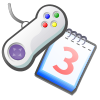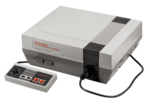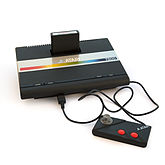- History of video game consoles (third generation)
-

Part of a series on: History of video games - History of massively multiplayer online games
- History of online games
- History of role-playing video games
Lists- Early history of video games
- First video game
- List of video games in development
- List of years in video games
- Timeline of video arcade game history
In the history of computer and video games, the third generation began on July 15, 1983, with the Japanese release of both the Nintendo Family Computer (later known as the Nintendo Entertainment System in the rest of the world) and Sega SG-1000.[1][2] This generation marked the end of the North American video game crash of 1983, a shift in the dominance of home video games from the United States to Japan,[3] and the transition from single-screen or flip-screen graphics to scrolling graphics, which would prove to be a pivotal leap in game design.[1]
Although the previous generation of consoles had also used 8-bit processors, it was at the end of this generation that home consoles were first labeled by their "bits". This also came into fashion as 16-bit systems like the Mega Drive/Genesis were marketed to differentiate between the generations of consoles. In the United States, this generation in gaming was primarily dominated by the NES/Famicom. The end of the 3rd generation of video games comes as 8-bit consoles become obsolete in graphics and processing power compared to 16-bit consoles.
Contents
Overview
The Family Computer (commonly abbreviated the Famicom) became very popular in Japan during this era and ended up crowding out the other consoles in this generation. The Famicom's Western counterpart, the Nintendo Entertainment System, dominated the gaming market in Japan and North America, thanks in part to its restrictive licensing agreements with developers. This marked a shift in the dominance of home video games from the United States to Japan, to the point that Computer Gaming World described the "Nintendo craze" as a "non-event" for American video game designers as "virtually all the work to date has been done in Japan."[3] Although the NES dominated the market in Japan and North America, Sega's Master System made large inroads in Europe, Oceania and Brazil, where the NES was never able to break its grip.[4] The Atari 7800 also had a fairly successful life in the United States, and the Sharp X68000 began its niche run in Japan in 1987.
The third generation would mark the move from single-screen or flip-screen graphics to scrolling graphics, which would prove to be nearly as pivotal as the leap to 3D graphics during the fifth generation. While hardware scrolling had been present in various arcade games in the early 1980s, during the golden age of video arcade games, it was not introduced to consoles until the third generation, with the 1983 release of the NES, the first console to feature hardware scrolling. The emergence of scrolling games opened up the possibility of vast worlds that made earlier single-screen games seem quaint. This gave Nintendo's NES a major advantage over its competitor, the Sega SG-1000, which was released on the same day but lacked hardware scrolling. Unlike the NES, the SG-1000 initially had very little to differentiate itself from earlier consoles such as the ColecoVision and contemporary computers such as the MSX. Despite the lack of hardware scrolling, Sega's SG-1000 Mark II was able to pull off some scrolling effects in 1984, including parallax scrolling in Orguss and sprite-scaling in Zoom 909.[1] In 1985, Sega's Master System incorporated hardware scrolling, alongside an increased colour pallette, greater memory, pseudo-3D effects, and stereoscopic 3-D, gaining a clear hardware advantage over the NES. However, the NES would still continue to dominate the important North American and Japanese markets, while the Master System would gain more dominance in the emerging European and South American markets.[4]
In the later part of the third generation (argued by some as part of the 4th generation as the Turbografx-16 was released in 1987 and the Sega Mega Drive was released in 1988), Nintendo also introduced the Game Boy, which almost single-handedly solidified, and then proceeded to dominate, the previously scattered handheld market for 15 years. While the Game Boy product line has been incrementally updated every few years, until the Game Boy Micro and Nintendo DS, and partially the Game Boy Color, all Game Boy products were backwards compatible with the original released in 1989. Since the Game Boy's release, Nintendo had always dominated the handheld market until present day.
The third generation saw many of the first console role-playing video games (RPGs). Editing and censorship of video games was often used in localizing Japanese games to North America. During this era, many of the most famous video game franchises of all time were founded. Some notable examples include Super Mario Bros., Final Fantasy, The Legend of Zelda, Dragon Quest, Metroid, Mega Man, Metal Gear, Castlevania, Phantasy Star, Megami Tensei, Ninja Gaiden, and Bomberman.
The third generation also saw the dawn of the children's educational console market. Although consoles such as the VideoSmarts and ComputerSmarts systems were stripped down to very primitive input systems designed for children, their use of ROM cartridges would establish this as the standard for later such consoles. Due to their reduced capacities, these systems typically were not labeled by their "bits" and were not marketed in competition with traditional video game consoles.
This generation is often mislabeled as the "First Generation" as it saw the beginnings of the video game industry as we know it today (although the grouping of generations is largely arbitrary).
Nintendo versus Sega
Main article: Console warsThe Nintendo Entertainment System (NES) / Family Computer (Famicom) sold by far the most units of any third generation console in North America and Japan. This was due to its earlier release, its strong lineup of first-party titles (such as Super Mario Bros. and Super Mario Bros. 3, The Legend of Zelda, and Metroid), and Nintendo's strict licensing rules that required NES titles to be exclusive to the console for two years after release. This put a damper on third party support for the other, less popular consoles. However, Sega's Master System was more popular than the NES in Europe, Brazil, Australia, and New Zealand, markets that were first reached by Sega. Many more games for the Master System were released in Europe and Brazil than in North America, and the console had a very long shelf-life in Brazil and New Zealand. In Europe, competition was tough for the NES, which was not as successful as the Master System in those other regions despite the hegemony that it had in the North American and Japanese markets.[5] The industry also started to grow in places west of the Soviet Union, including Lithuania via new programmers trained in that area. The Master System was finally discontinued in the late 1990s, while Nintendo of Japan continued to repair Famicom systems until October 31, 2007.[6][7][8]
Comparison
Name Famicom/NES Sega SG-1000 Casio PV-1000 Sega Master System Atari 7800 Console 



Launch prices ¥14,800
US$199.99
CA$240¥15,000 ¥14,800 ¥24,200
US$199.99US$140.00 Release date - JP July 15, 1983
- US October 18, 1985
- EU September 1 1986
- JP July 15, 1983
- AUS 1983
- JP October 1983
- JP October 20 1985
- AME June 1 1986
- WW September 1 1987
- AME June 1 1986
- WW September 1 1987
Media Cartridge and floppy disk (Japan only) Cartridge and Cassette (SG-3000) Cartridge Cartridge and data card Cartridge Top-selling games Super Mario Bros. (pack-in), 40.23 million (as of 1999)[9]
Super Mario Bros. 3, 18 million (as of May 21, 2003)[10]N/A N/A Hang-On and Safari Hunt (Pack-In) Pole Position II (pack-in)[citation needed] Backward compatibility None None None Sega SG-1000 (Japanese system only) Atari 2600 Accessories (retail) - Famicom Disk System
- NES Advantage
- NES Satellite
- NES Zapper
- Mattel Power Glove
- NES Power Pad
- NES R.O.B.
N/A N/A - Light Phaser
- Sega 3-D Glasses
- Sega Control Stick
- Sega Handle Controller
- Sega Paddle Control[11]
- Sega Pro Action Replay
- Sega Remote Control System
- Sega Rapid-Fire Unit
- Sega SG Commander
- Sega Sports Pad
CPU Ricoh 2A03 (based on MOS Technology 6502
1.79 MHz (1.66 MHz PAL)NEC 780C (Zilog Z80 clone) 3.58 MHz for NTSC, 3.55 MHz for PAL
D780C-1 (Z80A)
3.579 MHzNEC 780C (Zilog Z80 clone)
3.57 MHz (3.54 MHz PAL)Custom, 6502C (based on MOS Technology 6502)
1.79 MHzMemory 2 KB main RAM
2 KB video RAM
256 bytes sprite RAM
28 bytes palette RAM16 kB Main RAM
16 kB video RAM2 KB + 1 KB (character generator) 8 KB main RAM
16 KB video RAM4 KB main RAM Video 64 sprites (8 per scanline)
256x240 resolution
25 simultaneous colors
53 color palette256x192 resolution
32 sprites, maximum of 4 sprites per scanline
16 colors8 colors
256x192 resolution128 colors (16 colors with 8 intensity levels each) Unlimited sprites
320x200 resolution
25 simultaneous colors
256 color paletteAudio Mono audio with: - Two square waves
- One triangle wave
- One noise generator
- One DPCM channel
- One FM synthesizer (Famicom Disk system, Japan only)
Mono audio with: - 3 voices
- noise/vibrato effect
Unknown Mono audio with: - Three square waves
- One noise generator
- 9-channel, 2-operator FM synthesizer (Japan only)
Mono audio with: - Two square waves
Worldwide sales standings
See also: List of best-selling game consolesConsole Units sold Nintendo Entertainment System 60 million (as of August 4, 2007)[12] Sega Master System 13 million (as of September 6, 2005)[13][14] Software
Main article: List of console game franchisesSee also
References
- ^ a b c Travis Fahs. "IGN Presents the History of SEGA: Coming Home". IGN. p. 2. http://uk.retro.ign.com/articles/974/974695p2.html. Retrieved 2011-03-27.
- ^ Mark J. P. Wolf, The video game explosion: a history from PONG to Playstation and beyond, ABC-CLIO, p. 115, ISBN 031333868X, http://books.google.co.uk/books?id=XiM0ntMybNwC&pg=PA115, retrieved 2011-04-19
- ^ a b Arnie Katz, Bill Kunkel, Joyce Worley (August 1988), "Video Gaming World", Computer Gaming World, p. 44, "I'm sure you've noticed that I've made no reference to the Nintendo craze that has repeated the Atari and Mattel Phenomenon of 8 years ago. That's because for American game designers the Nintendo is a non-event: virtually all the work to date has been done in Japan. Only the future will tell if the design process ever crosses the Pacific as efficiently as the container ships and the letters of credit now do."
- ^ a b Travis Fahs. "IGN Presents the History of SEGA: World War". IGN. p. 3. http://uk.retro.ign.com/articles/974/974695p3.html. Retrieved 2011-05-21.
- ^ Travis Fahs. "IGN Presents the History of SEGA: World War". IGN. p. 3. http://uk.retro.ign.com/articles/974/974695p3.html. Retrieved 2011-05-21.
- ^ "Nintendo's classic Famicom faces end of road". AFP. 2007-10-31. http://afp.google.com/article/ALeqM5jAJfrC1k8lDKLOCGJu4VonjOYxBg. Retrieved 2007-11-09.
- ^ "初代「ファミコン」など公式修理サポート終了" (in Japanese). ITmedia News. ITmedia. 2007-10-16. http://www.itmedia.co.jp/news/articles/0710/16/news102.html. Retrieved 2008-01-20.
- ^ RyanDG (2007-10-16). "Nintendo of Japan dropping Hardware support for the Famicom". Arcade Renaissance. http://www.arcade-renaissance.com/2007/10/nintendo-of-japan-dropping-hardware.html. Retrieved 2008-01-20.
- ^ "Best-Selling Video Games". Guinness World Records. Archived from the original on 2006-03-17. http://web.archive.org/web/20060317005503/http://www.guinnessworldrecords.com/content_pages/record.asp?recordid=52404. Retrieved 2008-01-31.
- ^ "All Time Top 20 Best Selling Games". 2003-05-21. Archived from the original on 2006-02-21. http://web.archive.org/web/20060221044930/http://www.ownt.com/qtakes/2003/gamestats/gamestats.shtm. Retrieved 2008-01-31.
- ^ "-Sega Emulation Overview - another overview". retrocopy.com. http://www.retrocopy.com/sms.aspx. Retrieved 2010-04-30.
- ^ "NES". Classic Systems. Nintendo. Archived from the original on 2007-08-04. http://web.archive.org/web/20070804161605/http://www.nintendo.com/systemsclassic?type=nes. Retrieved 2007-12-04.
- ^ Russell Carroll (2005-09-06). "Good Enough: Why graphics aren't number one". Game Tunnel. http://www.gametunnel.com/articles.php?id=263. Retrieved 2007-10-28.
- ^ Sam Pettus (2007-01-21). "SegaBase Volume 2 - Master System and Game Gear". Eidolon's Inn. http://www.eidolons-inn.net/tiki-index.php?page=SegaBase+Master+System+and+Game+Gear. Retrieved 2007-10-28.
History of video games By generation First (1972–1977) · Second (1976–1984) · Third (1983–1992) · Fourth (1987–1996) · Fifth (1993–2006) · Sixth (1998–2011) · Seventh (2005–) · Eighth (2012–)By decade By year By system By genre Action game history · Action-adventure game history · Adventure game history · History of role-playing video games · Sports game history · Strategy video game historyThird generation video game consoles Action Max · Amstrad GX4000 · Atari 7800 · Atari XE Games System · Casio PV-1000 · Commodore 64 Games System · Nintendo Entertainment System · SG-1000 · Sega Master System2nd generation4th generationCategories:
Wikimedia Foundation. 2010.
